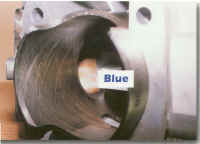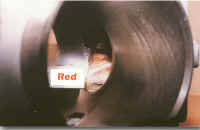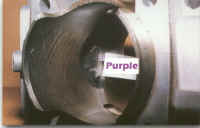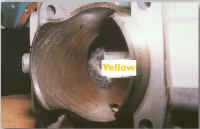|
So, they teamed up with Rotax engine experts, Lockwood Aviation
in Sebring, Florida, to design a test that would assure the new product
would continue to protect these engines.
Four
different oils were chosen for the test. The oils tested were:
1) Pennzoil" Two-Cycle Air-Cooled Engine Oil;
2) Pennzoil' Premium Out- board and Multi-purpose Two Cycle Oil;
3) A conventional petroleum two-cycle oil; and
4) A two-cycle synthetic oil.
Each
oil was color coded for identification and assigned to a particular engine
(see Table I at bottom of page.) To ensure a "blind test," the
technicians operating the test stand were unaware of which product was
used in each engine.
|
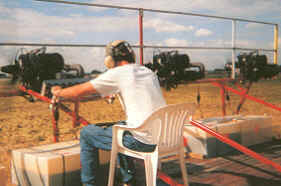 |
|
A
control panel allowed the operator to co-ordinate identical
operating conditions on all four engines simultaneously. |
Pennzoil'
Two-Cycle Air-Cooled Engine Oil is a low ash, two-cycle oil meeting API TC
requirements. API TC is the American Petroleum Institute standard for
Two-Cycle air cooled engines. Detergent additives incorporated into this
product help protect against high temperature piston ring sticking. This
product has gained wide popularity over the last ten years in sport
aviation two-cycle engines and is used in both air- and water-cooled
two-cycle sport aviation engines with great success.
Pennzoil'
Premium Outboard and Multi-purpose Two-Cycle Oil is a National Marine
Manufacturers Association
(NNOAA)
TC-W3* certified two-cycle oil (see sidebar - "How
Two-Cycle Oils Work") that also meets API TC. This product
incorporates ashless dispersant chemistry. This product is also used in
both air and water-cooled two-cycle sport aviation engines and is now
gaining popularity in Rotax 618 engine models, which are equipped with
Rotax Adjustable Variable Exhaust (RAVE) valves.
In
this test, the Pennzoil oils were compared to typical petroleum-based and
synthetic low-ash two-stroke oils.
It
is worthy to note that many pilots using synthetic oil may mix at a higher
(leaner) fuel/oil ratio than the engine manufacturer may specify.
Synthetic oils tend to work well against deposit formation at these
higher ratios, however engine manufacturers generally state that the
higher (leaner) oil ratio may not provide enough residual protection from
corrosion during extended storage conditions. Therefore, all oils run in
this test were run at the manufacturer's recommended fuel/oil ratio of 50:
1.
|
 |
|
After
280 hours of run time, the engines were torn down and inspected by
independent certified engine raters using Coordinating Research
Council industry standards. Here, Mike Maddox, National Manager of
Technical Service for Pennzoil in the foreground, records
measurements taken by Lockwood Aviation's Rotax Repair Specialist
Kerry Yunk. |
Four
new Rotax 503 two-cylinder fan- cooled engines were purchased and utilized
since it is one of the most popular engines in this market. Each engine
used a premix oiling system instead of the oil injection option. The
engines were fueled with premium unleaded gasoline that was mixed with the test oils at the engine manufacturer's recommended ratio of 50: 1. The engines were set up identically to achieve 6300 rpm at full throttle. After a one hour prescribed break-in cycle, the engines were run under strenuous one- hour cycles simulating a typical flight routine - i.e., full power takeoff, cruise, descent, and idle conditions (See Table 2 at bottom of this page).
The
Test
After
280 grueling hours, the engines were disassembled, rated for deposit
accumulation, piston ring sticking and measured for wear. Independent
certified engine raters used Coordinating Research Council (CRC) industry
standards to evaluate each engine in the areas of piston, ring and exhaust
port deposit accumulation, piston ring sticking, piston scuffing, and ring
and cylinder wear. Keeping these critical areas clean and free of deposits
and wear helps ensure longer engine life.
The
rating standards are based on a scale
from I to 10. The higher the rating, the better the evaluation or
performance of the lubricant in the specific area rated.
The
piston rings were rated as to the state of sticking and the degree of
circumference around the piston that they were stuck. Deposits were
evaluated by volume and appearance, ranging from 10 (clean- absence of
deposits) to 0.0 (maximum deposits - those deposits which take up ALL of
the available space between moving parts and display rubbed or polished
characteristics).
Resistance
against cylinder head, piston and ring land deposits is very important in
engines. Piston rings help remove heat from the piston and transfer it to
the cooler cylinder walls, as well as provide sealing between the
combustion chamber and crankcase. If deposits become too heavy and piston
rings become stuck in their grooves, then premature wear and damage will
occur due to the ring's inability 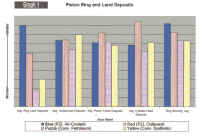 to properly seal the combustion chamber
and transfer heat. Excessive cylinder
head de- posits increase the octane requirement of the engine and may also
cause pre-ignition and detonation, leading to engine damage. to properly seal the combustion chamber
and transfer heat. Excessive cylinder
head de- posits increase the octane requirement of the engine and may also
cause pre-ignition and detonation, leading to engine damage.
Graph
I shows that Pennzoil' Premium Outboard & Multi-purpose Two-Cycle Oil
(identified as the red oil) performed exceptionally well, particularly in
the areas of combustion chamber cleanliness and piston crown deposits.
Pennzoil" Two-Cycle Air-Cooled Engine Oil (blue oil) performed
exceptionally well in the areas of resistance to piston ring sticking and
piston ring land deposits.
Graph 2 evaluates piston skirt deposits on both the thrust and anti-thrust
sides of the piston. The thrust side of the piston is the side that tends
to bear most heavily
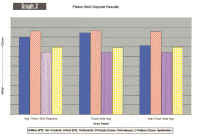 against the cylinder wall during the power stroke. The anti-thrust side of the piston tends to bear most heavily against the
cylinder wall during the compression stroke. When the transition occurs
from the compression stroke to the power stroke, the connecting rod angle
will change.
This change causes a sudden shift of the side thrust on the piston. If
there is any appreciable piston wear or deposits, contact of the piston
skirt with the cylinder wall can occur. against the cylinder wall during the power stroke. The anti-thrust side of the piston tends to bear most heavily against the
cylinder wall during the compression stroke. When the transition occurs
from the compression stroke to the power stroke, the connecting rod angle
will change.
This change causes a sudden shift of the side thrust on the piston. If
there is any appreciable piston wear or deposits, contact of the piston
skirt with the cylinder wall can occur.
Exhaust
Port Deposits
The
photographs below show the deposits inside of the exhaust
port. Deposit buildup in the exhaust port can affect the scavenging
proper- ties of the two-cycle engine. Also, in Rotax engines that
use RAVE valves, resistance of an oil to deposit buildup is critical for
proper operation of the variable exhaust valves.
The
blue oil (Pennzoil* 2-Cycle Air- Cooled Engine Oil) performed extremely
well as did the red oil (Pennzoil' Premium Outboard And Multi-Purpose
Two-Cycle Oil). The purple oil (conventional mineral) and the yellow oil
(synthetic) formed significantly
more deposits in the exhaust port area. However, "real world"
tests using synthetic oils at typical leaner mixtures show far less
deposits.
If
we had any doubts, these tests confirmed that oil obviously does make a
difference in the performance of a sport aviation engine! Pennzoil was
proud to confirm that its line of two- cycle oils continue to provide the
highest degree of performance in this demanding application.
|






